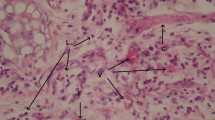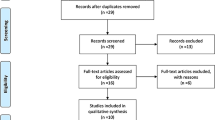Abstract
After traumatic perforation of the tympanic membrane (TM), healing occurs spontaneously in most cases, although occasional perforations will fail to close. Healing of epithelia at any site involves cell movement, with injury providing the stimulus to initiate changes in the behavior of cells that are normally static. Epidermal proliferation at the margins of the TM perforation can be accelerated by using such growth factors as epidermal growth factor, basic fibroblast growth factor (bFGF) and hyalorunan. bFGF is chemotactic and mitogenic for both fibroblasts and endothelial cells and is also mitogenic for keratinocytes. The effect of bFGF is significant in the enhancement of fibroblast production and angiogenesis. In this study, bFGF was used to enhance the healing process of chronic TM perforations in a guinea pig animal model. Chronic perforations were created since acute TMs could heal spontaneously without using any bioactive substance. In all, 30 TMs of 15 guinea pigs were used. A thermal myringotomy loop was employed to create a subtotal TM perforation at the area of the pars tensa. After establishing a permanent, non-infected perforation, bFGF in buffered saline solution was applied as 400 ng/day to 15 ears, while the opposite (control) ear was treated with only saline solution. At 20 days, 13 of 15 perforations treated with bFGF had closed. Light microscopy was used to assess organization of the healed TMs. The effects of bFGF on the healing process of TM perforations were compared in treated and non-treated ears.
Similar content being viewed by others
References
Amoils CP, Jackler RK, Lustig LR (1992) Repair of chronic tympanic membrane perforations using epidermal growth factor. Otolaryngol Head Neck Surg 107: 669–683
Amoils CP, Jackler RK, Milczuk H, Kelly KE, Cao K (1992) An animal model of chronic tympanic membrane perforation. Otolaryngol Head Neck Surg 106: 47–55
Baird A, Bohlen P (1990) Fibroblast growth factors. In: Sporn MB, Roberts AB (eds) Peptide growth factors and their receptors. Springer, Berlin Heidelberg New York, pp 1–15
Broadley KN, Aquino AM, Woodward SC (1989) Monospecific antibodies indicate that basic fibroblast growth factor is intrinsically involved in wound repair. Lab Invest 61: 571–575
Fujikura T, Hovell GJR, Hannninen O, Pelkonen K (1993) Guidelines for breeding and care of laboratory animals. World Health Organization and International Council for Laboratory Animal Science (ICLAS), vol 169, pp 95–97
Hellström S, Laurent C (1987) Hyaluronan and healing of tympanic membrane perforations. An experimental study. Acta Otolaryngol (Stockh) [Suppl] 442: 54–61
Lee AJ, Jackler RK, Kato BA, Scott NM (1994) Repair of chronic tympanic membrane perforations using epidermal growth factor: progress toward clinical application. Am J Otol 15: 10–18
Mondain M, Ryan A (1995) Epidermal growth factor and basic fibroblast growth factor are induced in guinea-pig tympanic membrane following traumatic perforation. Acta Otolaryngol (Stockh) 115: 50–54
Mondain M, Saffyedine S, Uziel A (1991) Fibroblast growth factor improves the healing of experimental tympanic membrane perforations. Acta Otolaryngol (Stockh) 111: 337–341
Ramsay HE, Heikkonen EJ, Laurila PK (1995) Effect of epidermal growth factor on tympanic membranes with chronic perforations: a clinical trial. Otolaryngol Head Neck Surg 113: 375–379
Stenberg BG, Phillips LG, Hokanson JA (1991) Effect of bFGF on the inhibition of contraction caused by bacteria. J Surg Res 50: 47–50
Vrabec JT, Schwaber MK, Davidson JM, Clymer MA (1994) Evaluation of basic fibroblast growth factor in tympanic membrane repair. Laryngoscope 104: 1059–1064
Author information
Authors and Affiliations
Rights and permissions
About this article
Cite this article
Özkaptan, Y., Gerek, M., Şimşek, Ş. et al. Effects of fibroblast growth factor on the healing process of tympanic membrane perforations in an animal model. Eur Arch Otorhinolaryngol 254 (Suppl 1), S2–S5 (1997). https://doi.org/10.1007/BF02439709
Issue Date:
DOI: https://doi.org/10.1007/BF02439709




